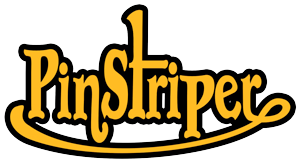Hand-painted pinstriping is a decorative art form that involves the application of thin lines of paint to surfaces, often adding flair to various objects like automobiles, motorcycles, signs, and even fine art pieces. The history of hand-painted pinstriping dates back several centuries and has evolved over time.
Early Origins: The origins of pinstriping can be traced back to ancient cultures where artisans adorned objects with intricate lines and designs. In ancient Egypt, for example, pinstripe-like patterns

were found on pottery and other artifacts. Similarly, Asian cultures like China and Japan have a rich tradition of intricate brushwork, which eventually influenced the development of pinstriping techniques.
19th Century: The modern history of pinstriping as an automotive and decorative art form can be traced to the 19th century. During this time, horse-drawn carriages and early automobiles began to be customized with decorative touches. Pinstriping was often applied to the edges of carriage panels and automotive bodies using brushes and striping quills. The lines were typically thin and elegant, adding a touch of sophistication to the vehicles.
20th Century: Pinstriping gained significant popularity in the early 20th century, particularly in the United States. As the automotive industry boomed and automobiles became more accessible, customization became an essential part of personalizing vehicles. Pinstriping was embraced by custom car builders, hot rodders, and motorcycle enthusiasts as a way to add unique and artistic elements to their vehicles. During this era, prominent pinstripers emerged, such as “Von Dutch” (Kenny Howard) and “Big Daddy” Ed Roth. These artists contributed to the evolution of pinstriping techniques, experimenting with different brushes, paints, and styles. Pinstriping was not limited to vehicles; it also found its way onto various consumer products, signs, and even clothing.
Modern Era: Hand-painted pinstriping continues to thrive in the modern era, although its popularity has gone through ebbs and flows. With the advent of vinyl graphics and computer-generated designs, traditional hand-painted pinstriping faced some competition. However, many enthusiasts and artists continue to value the authenticity, uniqueness, and tactile nature of hand-painted work.Contemporary pinstripers often use a combination of traditional and modern tools. Fine brushes, custom-made striping brushes, and quality enamel or urethane paints are commonly used. Pinstriping can be seen on a wide range of surfaces, from vintage and custom vehicles to modern motorcycles and even art pieces.In recent years, pinstriping has gained renewed attention as part of the broader “retro” and “vintage” aesthetics. Many artists and enthusiasts have embraced pinstriping as a way to connect with the past and add a touch of nostalgia to modern designs.
Overall, the history of hand-painted pinstriping reflects its evolution from ancient decorative traditions to a distinctive automotive and artistic expression, demonstrating its enduring appeal across centuries and cultures.
